The Best Pole Saws of 2025, Tested and Reviewed
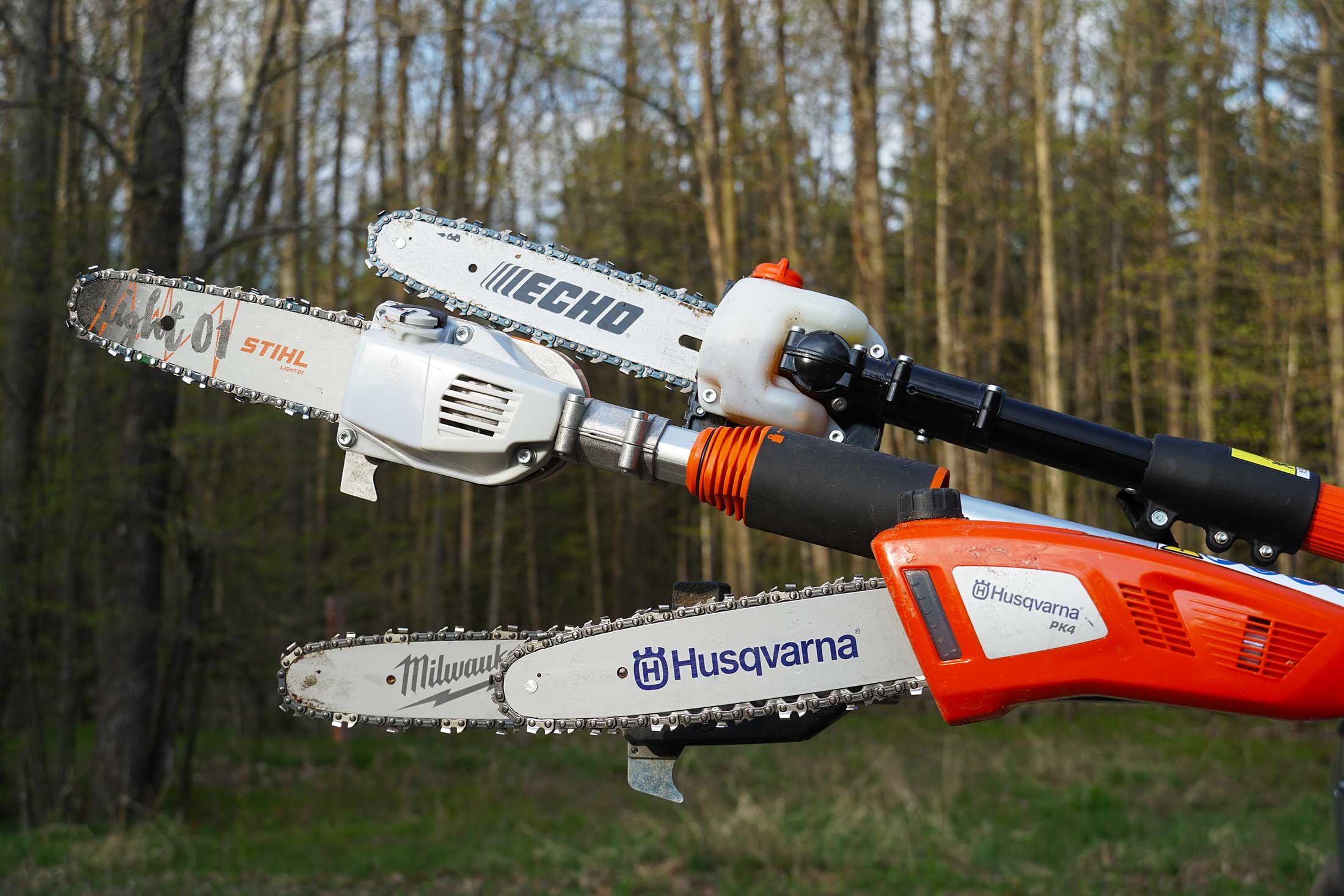
We may earn revenue from the products available on this page and participate in affiliate programs. Learn More ›
The best pole saws can be used for a lot more than trimming branches in the backyard. The top battery- and gas-powered saws will also help you clear trails, remove brush, cut shooting lanes on a hunting property, and implement timber stand improvement projects.
With the help of my cousin, I recently put the full field of the top consumer-level electric and gas pole saws to the test on my family property in northern Wisconsin (find our full testing protocol here). While I was a bit surprised by how expensive these pole saws were, I was also impressed by their performance. I would happily run any of the saws in this review, though a few stood tall above the rest.
Best Pole Saws:
Manual Polesaws to Consider:
Best Pole Saws, Reviews & Recommendations
Best Electric: Stihl HTA 135
See It
Pros
- Wicked fast
- Great balance
- Excellent battery life
Key Features
-
Telescoping pole -
Manufactured in USA -
Weather resistant (IPX4 rated) -
Precise trigger for variable speed
Key Specs
-
Bar length: 10 inches -
Max length (trigger to bar tip): 11.5 feet -
Weight : 20.2 pounds (measured) -
Battery: 36V; 7.2 AH -
Average cut time: 4 seconds -
Price: $1,050
This was the heaviest and most expensive pole saw in the test, but it also delivered the most overall performance and speed. The Stihl HTA 135 proved to be super smooth, intuitive to use, and it extended to an impressive 11.5 feet (the longest in the test).
While cutting with this saw we found it to balance nicely and it didn’t wear us out as quickly as expected, given its overall weight. Its most direct competitor is the Echo X Series, which is also a great polesaw (and it’s a bit less expensive). However, in our field test we noticed that the Stihl just zipped through limbs and branches more easily. It was also easier to cut with at height, even though the pole did wobble a bit more than the Echo’s.
The Stihl’s trigger and controls are precise and intuitive. It’s very easy to extend the pole and lock it in place, and we never had it slip while working. Its battery life was impressive and I expect that you’ll tire out well before the saw does. The only small quibble we had with this pole saw was that the strap connection point can pull free under enough force. It’s a cool design, because it allows you to place the harness strap anywhere on the pole. But it should be more sturdy.
Other than that, this is the best battery-powered pole saw for serious DIY work in the yard, at camp, or on the ranch.
Best Gas: Stihl HT 56CE
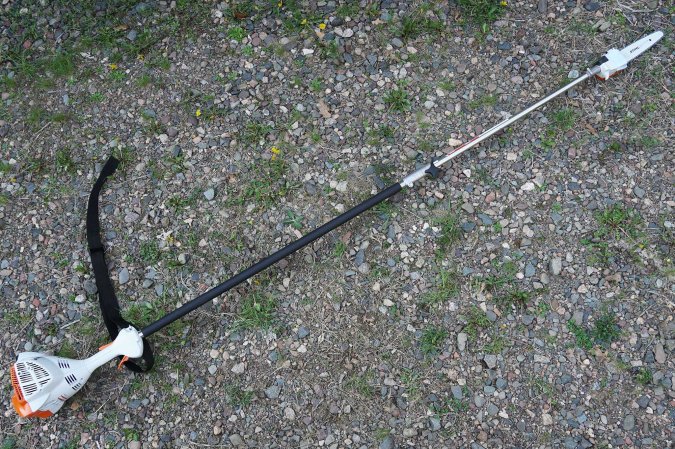
See It
Pros
- Fastest gas saw in the test
- Relatively affordable
- Smooth
Cons
- Limited length, does not extend
Key Features
-
2-piece shaft for easy storage and transportation -
Stihl easy-start feature -
Made in America
Key Specs
-
Bar length: 10 inches -
Max length (trigger to bar tip): 8 feet -
Weight : 15.7 pounds (measured) -
Average cut time: 5 seconds -
Price: $420
Of all the pole saws in the test, this is the one I’d spend my money on. It’s relatively affordable, it’s fast and smooth, and it’s lighter than the heavy duty battery-powered polesaws. I was impressed with how smoothly it runs — there’s no undue vibration or wobble in the pole.
I pulled this pole saw from my truck bed and gave it to my cousin Shawn to run. He fired it up and was gone, piles of cut branches and limbs lay in his path. When I caught up with him about 30 minutes later, he had a big smile on his face, “You can get a lot of work done with this thing,” he said. And he was right.
Because the saw is light, handy, and powerful, you can cover ground with it quickly. On the downside, it does not have an extendable pole. So if you plan on trimming really high branches, you’d be better off with the extendable electric version.
But I think for most everyday users, this is the best pole saw all-around in the consumer category.
Best Value: Milwaukee M18 Fuel Quik-Lok
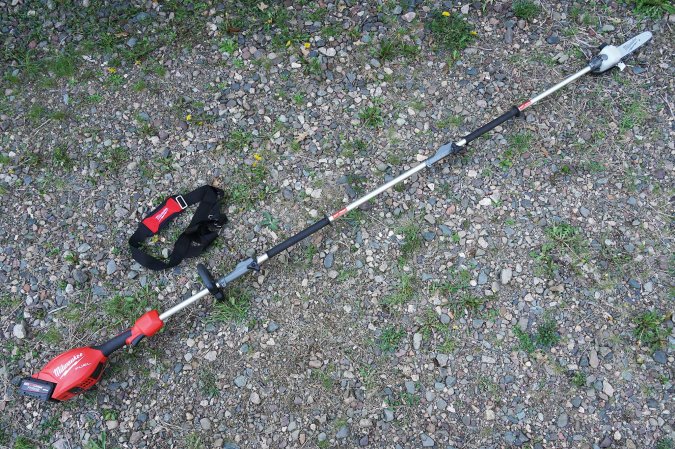
See It
Pros
- Light for a battery saw
- Versatile, with multiple attachment options
- Great value if you already have Milwaukee tools
Cons
- Wobbly pole when used with both extensions
Key Features
-
Compatible with 13 Milwaukee QUIK-LOK attachments -
Includes two extension pieces -
Made in Mexico
Key Specs
-
Bar length: 10 inches -
Max length (trigger to bar tip): 8.75 feet -
Weight : 15.4 pounds (measured) -
Battery: 18V; 8 AH -
Average cut time: 5.3 seconds -
Price: $500
The coolest thing about the Milwaukee pole saw is the ingenious “Quik-Lok” environment in which it lives. In this package, Milwaukee essentially gives you a powerhead and shaft that can connect to 13 different attachments — ranging from a string trimmer, to leaf blower, to brush cutter. You swap between attachments by simply loosening a knob and pressing a button. No tools required.
I of course tested the pole saw version of the Quik-Lok family and was impressed by its speed and power. This clearly isn’t just a gimmicky system, as the Milwaukee hybrid kept pace with the other pole saw purebreds.

Fully extended, I did find the pole to be a little wobbly. This didn’t prevent me from cutting through thick limbs at height but it did require extra effort while working. On the bright side, this is a relatively light pole saw (especially for an electric option). And with one of the extension bars removed, it was extremely handy to operate in the woods.
If you already run Milwaukee equipment and have an M18 series battery, this tool becomes a heck of a deal. And even if you don’t, it would be a great starting investment in a fleet of interchangeable outdoor power tools.
Best for Backyards: Husqvarna 120iTK4

See It
Pros
- Very light
- Good ergonomics
- Solid value
Cons
- Limited power
- Limited speed
Key Features
-
2 speed settings -
Telescoping pole -
Compatible with hedging attachment -
Made in Sweden
Key Specs
-
Bar length: 10 inches -
Max length (trigger to bar tip): 8.5 feet -
Weight : 11.8 pounds (measured) -
Battery: 36V; 4 AH -
Average cut time: 8 seconds -
Price: $290
If you’re looking to do some light duty, backyard trimming then this Husqvarna battery powered polesaw is for you. It was the lightest saw in our test, and it was also the easiest to run. I loved the ergonomics of the handle. Getting the pole to telescope in and out is a breeze.
I also liked that this saw has two speed settings. Running at slower speed preserves battery life and is more effective for trimming small branches. Juice it up to full speed when cutting larger branches.
The Husky is also the least expensive electric saw in the test — by a long shot.
On the downside, the pole is wobbly when extended (especially compared top end pole saws like the Echo and Stihl). We did have some trouble with the saw jamming up and getting pinched while working in the woods. It was also the slowest electric saw in our test. Lastly, there’s a lot of plastic around the oiler and bar, so you won’t want to use this saw as a battering ram. But for ordinary backyard trimming, this polesaw will certainly do the trick.
Best Heavy Duty: Echo X Series DPPT 2600H
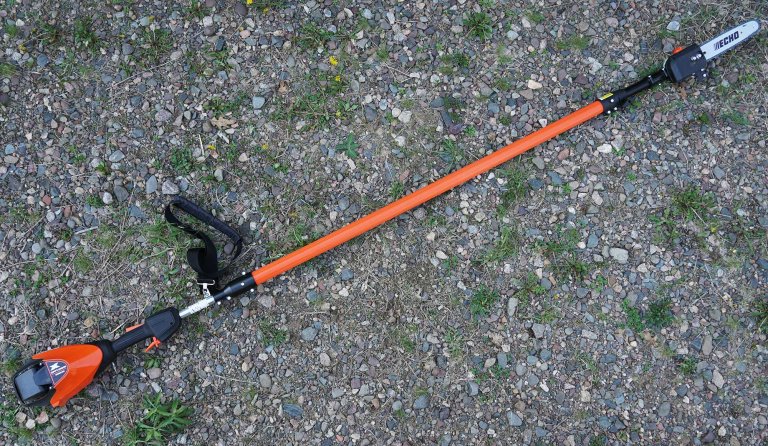
See It
Pros
- Hefty and sturdy
- Fast and powerful
- Relatively affordable
Cons
- Not as well balanced as the Stihl
Key Features
-
Adjustable speed -
Telescoping pole -
Optional extension -
Assembled in the USA
Key Specs
-
Bar length: 10 inches -
Max length (trigger to bar tip): 11 feet -
Weight : 17.9 pounds (measured) -
Battery: 56V; 5 AH -
Average cut time: 6.3 seconds -
Price: $800
Even though this powerful battery-powered X Series pole saw weighed less than the Stihl, it still felt more solid and heavy-duty. It has a hefty pole that did not wobble or sway, even when fully extended. This made cutting large limbs at height easy work.
We really liked the variable speed button near the trigger. This allows you to run the chain at a lower speed or higher speed depending on the job (without having to worry about feathering the trigger perfectly). The only reason it lost out to the Stihl as our best battery-powered pole saw was because it was a little slower, not quite as well balanced, and the telescoping adjustment was not as clean.
However, this pole saw costs about $250 less than the Stihl. So if you want pro-level performance without having to spend top dollar, then I’d recommend the Echo without hesitation.
Echo PPF 2620
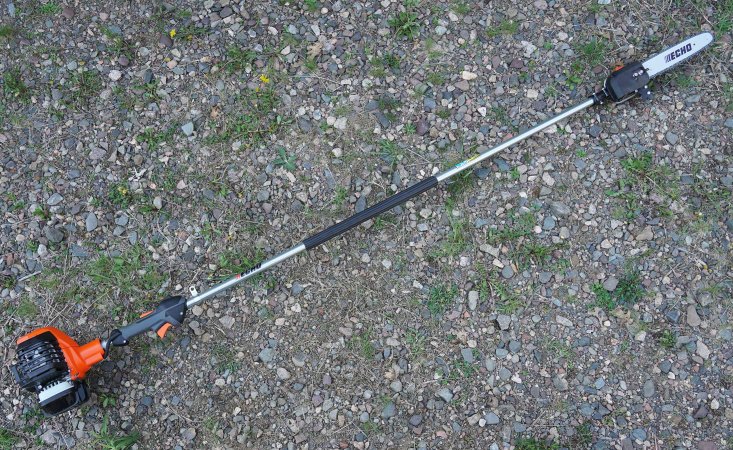
See It
Pros
- Fast
- Relatively affordable
- Longer bar
Cons
- Limited length
- More expensive than the Stihl
Key Features
-
1-piece shaft -
25.4cc engine -
Assembled in the USA
Key Specs
-
Bar length:12 inches -
Max length (trigger to bar tip): 6.5 feet -
Weight : 13.1 pounds (measured) -
Battery: 56V; 5 AH -
Average cut time: 6.3 seconds -
Price: $550
This is a handy and fast polesaw that was just barely slower than the Stihl gas saw in our speed test. During field work we liked the Echo’s balance and the longer 12-inch bar was a nice touch too. If you want to cut down some really big branches, this would be the go-to pick.
The only downsides of this saw are that it is a little shorter and a little more expensive than the Stihl gas pole saw. But overall we found this to be a well-made, durable, and fast saw that can handle basic backyard trimming and more serious work in the woods.
Husqvarna 122LK
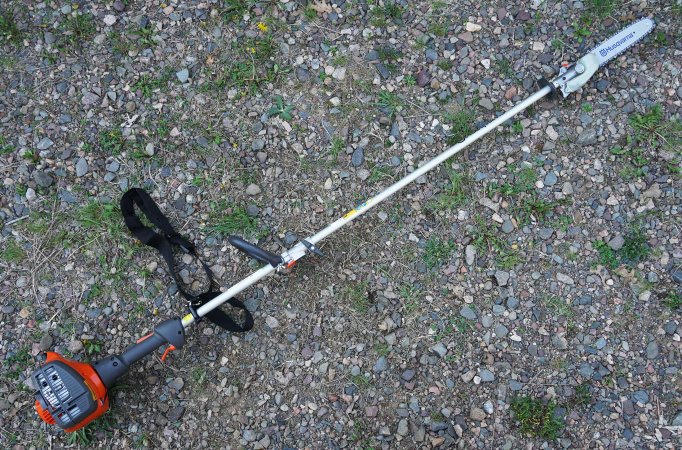
See It
Pros
- Affordable
- Light
- Versatile
Cons
- Lacked cutting performance
- Limited height
- Jammed up on occasion
Key Features
-
Compatible with other attachments -
Made in China
Key Specs
-
Bar length:12 inches -
Max length (trigger to bar tip): 6 feet -
Weight : 13.1 pounds (measured) -
Battery: 56V; 5 AH -
Average cut time: 13.7 seconds -
Price: $300
Similar to the Milwaukee, the Husqvarna powerhead can take multiple attachments, including a string trimmer, hedge trimer, and edger. The polesaw version of this tool is handy for backyard use, but is not on par with the other top-end pole saws in this test. It had some issues in the speed test (recording the slowest average time) and it got hung up the most often in the field (compared to other products in this review).
That said, this little Husky is light, handy, and affordable. If you wanted a selection of gas-powered backyard tools that all utilized the same powerhead, this would be a fine route to go.
Read Next: Best Electric Chainsaws, Tested and Reviewed
Manual Pole Saws Worth Considering
Best Value: Fiskars Extendable Tree Pruner and Pole Saw
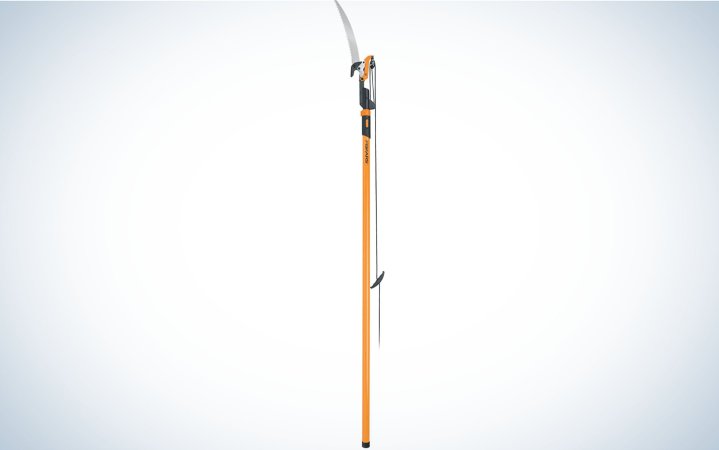
See It
Pros
- Chain drive provides more cutting power
- Affordable
Cons
- Lots of flex in pole at full length
Key Features
-
Saw and chain-driven pruner -
Lifetime warranty
Key Specs
-
Max Length: 16 feet -
Blade Length: 15 inches -
Weight: 5 pounds (approx) -
Price: $90
This is a typical manual pole saw with one nice feature: it has a chain drive to provide more cutting power to its steel pruner. Fiskars says it provides three times more power than the standard pruner and you can cut branches up to 1.25 inches in diameter with its chain-driven pruner. That’s actually a decent sized limb.
For larger branches, the 15-inch cutting blade has aggressive teeth and a hook at the end to prevent it from slipping out of the cut. The locking mechanism for the telescoping pole prevents the pole saw from pulling apart while sawing bigger branches, which is a common problem with cheap pole saws. This is the longest saw in the review, and it can reach branches high off the ground. However you’ll notice a good amount of flex in the pole at max height, which makes cutting a challenge.
Best for Hunters: Hooyman Extendable Pole Saw
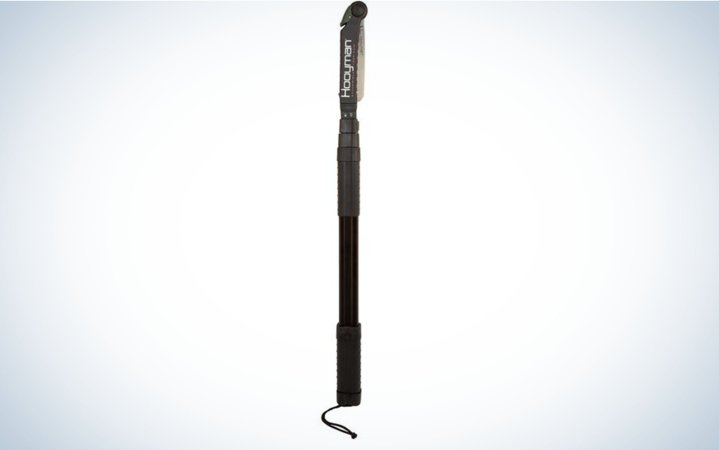
See It
Pros
- Light, packable, and portable
Key Features
-
Locking extension system -
Can be used as a hand-held saw -
Limited lifetime warranty
Key Specs
-
10 feet or 5 feet -
28 inches (10 foot model) / 12 inches (5-foot model) -
1.55 pounds (5-foot model) -
Blade length: 13 inches -
Price: $50 (5-foot); $72 (10-foot)
If you’ve got to trim shooting lanes well off the trail, you need a collapsable, packable saw like the Hooyman. There are two versions of this saw: a 10-foot model that collapses down to 28 inches or a 5-foot model that collapses down to just 12 inches.
The 10-foot model is great for clearing lanes before the season. You could easily stash the 5-foot model in your hunting pack, so when you climb into your stand only to notice there’s a limb blocking the main trail, you can stealthily cut it down. This is an ideal tool for hang-and-hunt bowhunters who might have to clear only a branch or two for their treestand setup.
The saw part is removable, so you can use it as a handsaw if you like. The Megabite teeth on the saw are super aggressive and chew through branches quickly.
How I Tested Pole Saws
I recruited my cousin to help me test pole saws on our hunting property in northern Wisconsin. Fresh out of the box, I conducted a speed test with each saw, by running them through a 4-inch diameter oak limb. I timed how long it took each saw slice through and each got three attempts, which I averaged. The battery-powered saws with adjustable speed were tested at their highest setting.
To check battery life, I ran each electric saw through the oak limb 30 times without stopping. None of the saws overheated, and all showed full or 75 percent battery life.
Then we used the saws to clear trails. We took down tall limbs and zipped through small trees at ground level. We evaluated how well each saw handled, balanced, and powered through its cuts. When the sawdust settled, we picked our favorites.
A note on specs: I weighed all of the saws with gas, bar oil, and batteries included (since that’s how you’d run them). For the length spec, I measured from the tip of the bar to the trigger. I consider this to be the usable length of the pole saw and it’s why my spec will be shorter than what you see published on manufacturer’s websites. For price, I shopped around online and then linked to the lowest price that was also widely available.
What to Consider in a Pole Saw
Gas vs Electric
Electric saws in this test had longer poles, and were generally faster than the gas saws. They’re also quieter. On the downside, the electric saws are heavier and more expensive than their gas counterparts. If price is no option and you’re not scared of a heavy saw, go with a high-end battery powered model. If you’re looking to save some money, go with a gas pole saw.
Length
Obviously, the longer the pole, the higher you’ll be able to cut. If you plan on trimming high hanging branches, you’ll need a long telescoping pole in the 11-foot range.
Weight
Running a heavy pole saw will tire you out quickly. In general, the benefit of a heavy saw is a sturdier pole, more height, and extra power. Picking the best pole saw for you all comes down to what kind of work you plan on doing. If you intend to cut down big branches at height, then you’ll have to suck it up and go with the heavier saw.
If you plan on doing more casual work in the backyard or you want to cover lots of ground, then opt for a lighter saw.
Final Thoughts on the Best Pole Saws
All of the saws that I tested were capable in the field. I’m confident that each will work well, so long as it’s given a job that it was designed for. The heavy duty Stihl and Echo battery powered saws were the highest performers. The Stihl and Echo gas saws were the best performers for the price. The little electric Husky is a great option for backyard trimmers and gardeners. And the Milwaukee stands out for its combination of versatility, cutting speed, and value. I don’t think you could go wrong with any of those options.
Read the full article here









